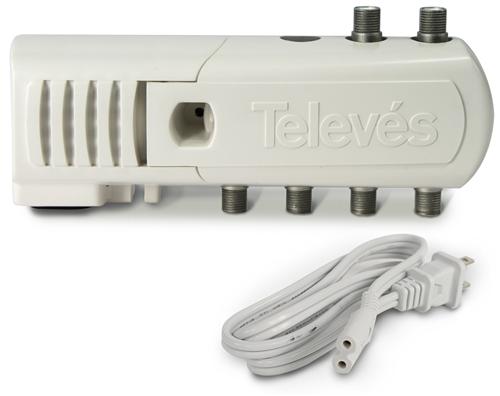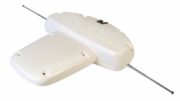Your antenna is on the roof. Your TV is all the way on the other side of the house. Is it going to be a problem? Unless you’re living in the old Aaron Spelling mansion, probably not. Let’s take a look at why.
TV signals are pretty strong compared to…
The average TV signal coming in is much, much stronger than a satellite signal. This isn’t surprising since satellite signals come from 22,000 miles away give or take, and TV signals are much closer than that. Satellite signals are so weak they need to be amplified before they even go on a cable. While you can amplify an antenna signal before it goes to the wire (that’s called a preamplifier) you don’t always have to. It depends on your situation.
I’m bringing this up because satellite signals can be distributed through very large buildings so if they can do it, antenna signals can too.
On the other hand, they’re pretty weak compared to…
well… pretty much anything else. TV signals start out at about 100,000 watts. By the time a signal from 50 miles away reaches your TV, the signal has dropped to .0000001 watt give or take. That’s right, it’s lost that much power. When you think about it that way, it’s pretty amazing that broadcast television works at all. It’s even more amazing that it can lose about 90% of that signal power before it starts to break up. Still, it’s important to manage your cables properly so you get great TV signal in every room.
The secret is…
If you’re sending TV signals over a long distance, you need a distribution amplifier. A distribution amplifier’s specific design overcomes the losses created by splitters and long cable runs. Unlike a preamplifier, it works inside the home, providing just enough power to get the signal to the next splitter or to the TV.
Choosing the right amplifier
Choose an amplifier with multiple outputs if you need to go to many TVs, or a single output if you’re looking to overcome a long cable run. As a general rule, good quality RG6 cable loses about 5dB of signal strength over a 100 foot run. (What is a dB? I’m glad you asked.) So, this distribution amplifier will let you run 300 feet if you don’t split the cable in the meantime.
If you plan on splitting, an 8-way splitter will reduce the signal level by about 14dB. That means you could use the same amplifier ahead of an 8-way splitter to completely eliminate the loss from that splitter.
If you need runs that are longer than that, you can generally add a second distribution amplifier. You can’t keep adding more and more and more of them, but in general you will find that you can add up to three distribution amplifiers if you need to.
How can you know for sure?
The only way to know for sure how much amplification you can tolerate is to measure it. A signal meter like this one will tell you how strong your signal is at any point in the installation. More importantly, it will tell you the signal-to-noise ratio, which is the most critical measurement in antenna television. Because all TV is digital, the only thing that matters is whether or not the TV’s tuners can tell a “1” from a “0.” Your raw signal strength isn’t that important, as long as it’s enough to overcome the cable and splitter loss.
Each device, whether it’s an amplifier, a splitter, or a connector, adds noise to your antenna cable run. You can’t get rid of this noise, but you can generally keep amplifying the signal so that the noise isn’t too much of a problem. Eventually though you get to the point where things are so noisy that no amount of amplification is going to help.
If you’re planning a big antenna installation, the best thing you can do is call the fine folks over at Solid Signal. They can help you plan all the parts you’ll need to make sure the installation goes as well as possible, and give you advice on whether or not the cable runs you’re considering are going to be a problem.
As always, the number is 888-233-7563 and the techs are available Monday-Friday during business hours. If it’s after hours, just fill out the form below. We’ll get back to you promptly.





